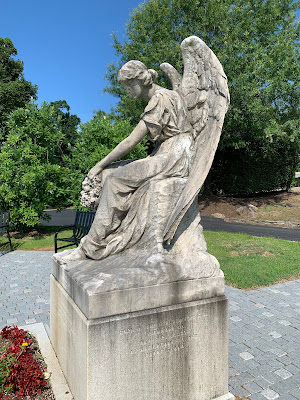We visited Hollywood Cemetery about 25 years ago and I remember it as one of the most interesting cemeteries I've ever visited. So the next day we headed into Richmond for the day and our first stop was at Hollywood Cemetery.
Founded in 1847, Hollywood is one of the oldest cemeteries in Richmond. Confederate President Jefferson Davis, General J.E.B. Stuart, Presidents James Monroe and John Tyler, 18,000 Confederate soldiers, and 11,000 of the unknown are a few examples of the historical figures buried here. Hollywood has the city's best view of the James River. When the cemetery was first established, neighbors declared that the rushing of the falls would, literally, wake the dead.
We headed up the hill to Presidents Circle to see the two United States Presidents.
They are very close together and we wondered why - we would learn the answer to that later.
James Monroe died in New York City in 1831 and was interred in Marble Cemetery. In 1856, Virginia Governor Henry Wise sought to repatriate the remains to his native state. The state appropriated funds and Monroe's remains were transported to Richmond aboard the steamship Jamestown. The tomb, which was erected in 1859, is considered architecturally significant first for the scale of its use of cast iron, a material not commonly used at the time for that purpose, and for delicacy and flamboyancy achieved in its creation, which could not have been done in stone.
In 2015, as part of plans to celebrate the 200th anniversary of Monroe's election as America's fifth president, Monroe's tomb received a $900,000 makeover from the Virginia Department of General Services. Almost 40% of the tomb's cast iron structure was repaired and returned to a color closer to its original state - it was black the last time we saw it.
The tomb is commonly referred to as The Birdcage.
James Monroe, 1758-1831
President John Tyler, the tenth president of the United States, was buried in Hollywood Cemetery in 1862. His death was the only one in presidential history to not be officially recognized in Washington D.C. due to his allegiance to the Confederate States of America. Tyler requested arrangements for a simple burial, but Confederate President Jefferson Davis hosted a grand event, complete with a Confederate flag draped over the coffin.
John Tyler, 1790-1862
So why President's Circle and why are the two buried so close together? We learned that at one time there was a plan to have the Virginia presidents all buried together in Hollywood Cemetery. After James Madison and John Tyler were interred here, the plan fell apart and no others joined them.
On to another president, Jefferson Davis, the first (and only) president of the CSA.
Jefferson Davis, 1808-1889
What's that bird on his head?
After his death, Jefferson Davis was buried in Louisiana. After four years and at the request of his widow, Varina Davis, his remains were removed with great ceremony and brought to Richmond, the capital of the Confederacy.
His wife is now buried with him.
A few other notable graves.
George Edward Pickett was a career US Army officer who became a major general in the Confederate States Army during the Civil War. He is best remembered for being one of the commanders at Pickett's Charge, the futile and bloody Confederate offensive on the third day of the Battle of Gettysburg that bears his name.
Sallie Pickett, wife of George Pickett, 1843-1931
The Unknowns are right there by him. It seems that some have been identified and their stones have been replaced with the details.
And then on to Jeb Stuart.
James Ewell Brown, "J.E.B.", Stuart 1833-1864
James Ewell Brown Stuart was a US Army Officer who became a Confederate States Army general during the Civil War. He was known to his friends as "Jeb" from the initials of his given names. He was a cavalry commander known for his mastery of reconnaissance and the use of cavalry in support of offensive operations. While he portrayed a cavalier image (red-lined gray cape, the yellow waist sash of a regular cavalry officer, hat cocked to the side with an ostrich plume, red flower in his lapel), his serious work made him the trusted eyes and ears of Robert E. Lee's army and inspired Southern morale.
What a great morning of exploration in this beautiful cemetery. But it's time to move on.


















I’ve been to Richmond a gazillion times but never to this cemetery. Sounds like something I should do this summer.
ReplyDeleteWhat? So close!
Delete